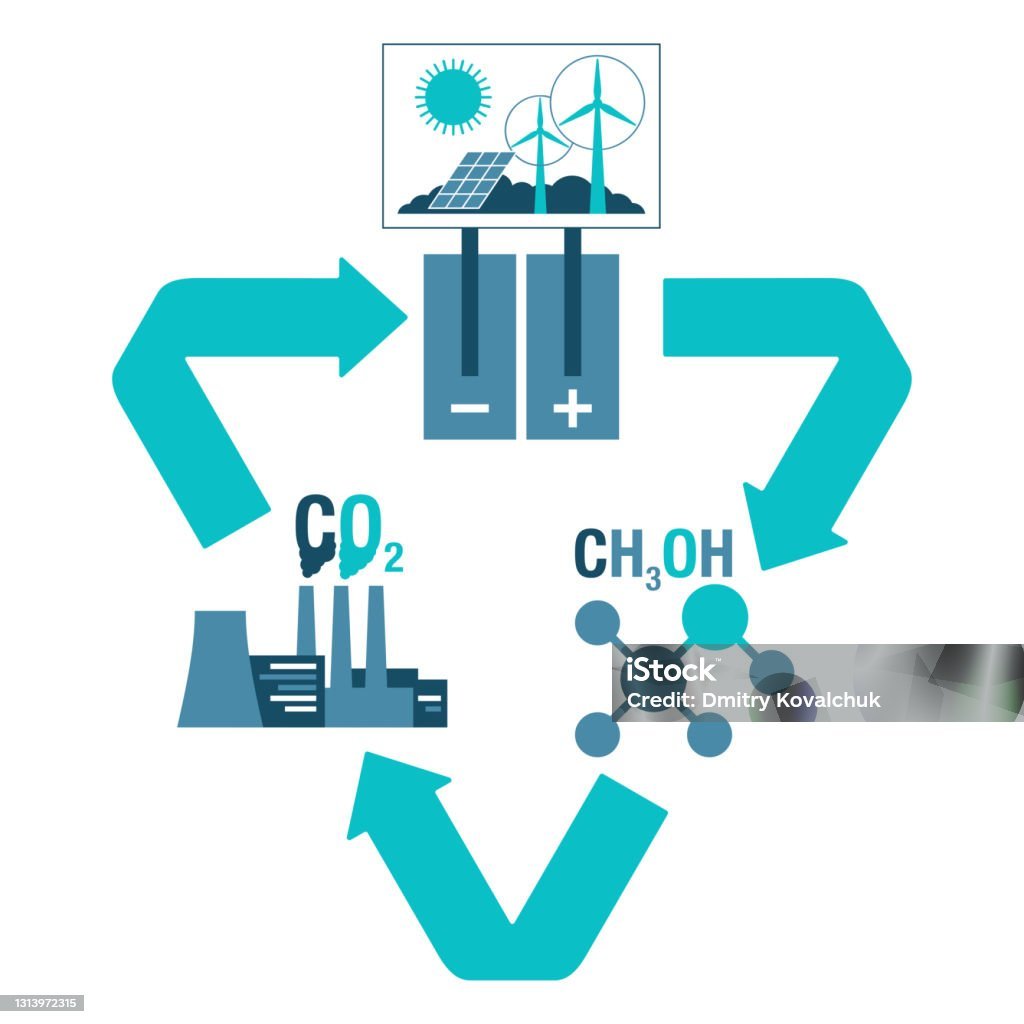Several advantages and challenges in using hydrogen as fuel were addressed in our previous article. There is no doubt in hydrogen’s ability to fill the shoes of a clean and efficient fuel that we expect. However, due to technological, sourcing, political, policy-making, and safety reasons, it might take a while before hydrogen could replace the existing fossil fuels. At the same time, we can’t continue the usage of fossil fuels at the rate we are using now due to several environmental reasons. To bridge this gap, where we reduce the usage of fossil fuels and start using hydrogen as a fuel, we need to find ways to store and transport energy efficiently. Methanol (CH3OH) is a liquid at room temperature and is the simplest of alcohols that would enable us to bridge this gap. It not only boils at relatively lower temperatures (~65°C), but it also has the highest hydrogen to carbon ratio for any liquid fuel at room temperature, making it a cleaner fuel. This article discusses various aspects of the “Methanol Economy” and how crucial it is in tackling the modern-day energy-economics-environment war.
Methanol has multiple applications. Methanol is a commodity chemical and is used as a feedstock for producing various other chemicals such as formaldehyde and olefins. These can be used to synthesize chemical products such as polymers that touch our day-to-day lives. Currently, these products are manufactured from fossil sources. Moreover, in its pure form, methanol can be used as a fuel in internal combustion engines or by mixing with gasoline. Nowadays, methanol is seen as a promising marine fuel by the major players in the ship industries, such as Maersk and MAN. Maersk was recently in the news for ordering 12 carbon-neutral container vessels that would operate on methanol. This is because methanol as a fuel produces significantly lesser amounts of SOx, NOx, and particulate matter than conventional fuels. Methanol can also be used as cooking fuel. The Government of Assam conducted the Methanol Cooking Fuel Program in 2018, creating awareness about using methanol as a cooking fuel that eventually would enhance indoor air quality.
Furthermore, since a single methanol molecule can carry four hydrogen atoms, it can be used as a hydrogen carrier. Being a liquid, the existing infrastructures can easily be leveraged to store and transport methanol. Renewable methanol is produced using the CO2 emitted from the flue gas and green hydrogen. This is looked into as a way to reduce the atmospheric CO2 concentrations (or at least as a way to mitigate its deleterious impacts) and to store the excess renewable energy. As discussed in the previous article, storage and transportation are the most difficult challenges in adapting hydrogen as a fuel. Renewable methanol can overcome these limitations until technological advancements occur in hydrogen storage and transport. Power to liquid (PtL) technologies such as methanol production from renewable resources help reduce intermittency in renewable power generation.
Methanol can be “polygenerated”. It means that it can be produced from various sources such as syngas, CO2, biomass, and municipal solid waste and can effectively help in waste management. India is one of the largest coal reserves in the world. However, there are many environmental issues with using coal as a fuel. Instead, coal can be gasified to produce syngas, which can then be converted into methanol. Coal to fuels is seen as a viable option to utilize coal cleanly. Recently BHEL commissioned a pilot plant to produce methanol from coal. Since methanol can be made from various feedstocks, it can be locally produced, increasing the energy security of countries and reducing the foreign dependence on fuel.
Awareness of renewable methanol is observed all along the globe. Iceland-based Carbon Recycling International (CRI) commissioned a 4000 tons renewable methanol production plant per year named after Noble Laurate Prof. George Olah. Further, they established a commercial-scale renewable methanol plant of 110000 tons per year in the Henan province, China. According to their web data, this plant recycles about 160000 tons of CO2 annually.
In a nutshell, the “Methanol Economy” comprises three different functions for renewable methanol
i. Methanol as a clean fuel
ii. Methanol as energy storage and transport medium
iii. Methanol as a feedstock for producing other chemicals
Provided its advantages, Methanol Institute (MI) recommended several policies for adopting the methanol economy into the Indian energy and fuel mix. Some of the key recommendations are as follows,
· Acknowledging methanol and hydrogen as key energy carriers
· Facilitating R&D and pilot projects toward enhanced methanol production
· Better supply chain network for methanol
· Awareness and supportive policy landscape for methanol
Researchers, corporates, government bodies, and start-ups worldwide are looking for an affordable alternative energy source that doesn’t harm the environment. In our first article, we discussed why we might not be able to completely move away from carbon-based energy sources in the near future. In our previous article, we discussed how hydrogen could be the answer to all these questions, but they had traces of carbon involved while producing them, making hydrogen (except green) “not so clean”. Also, hydrogen had several technical drawbacks in handling, storage, and transport. As we technologically move towards a hydrogen-based economy, reducing the dependence on fossil fuels is critical for several environmental and political reasons. Still, it has to be done mainly for the sake of the environment. Methanol could act as a bridge facilitating a smooth transition between the current generation fossil fuels to the next generation hydrogen fuels.
References:
1. https://www.carbonrecycling.is/
2. https://www.methanol.org/
Author – Ajay Koushik V, Research Scholar, Kinetics and Catalysis Research Group, IIT-Madras.



